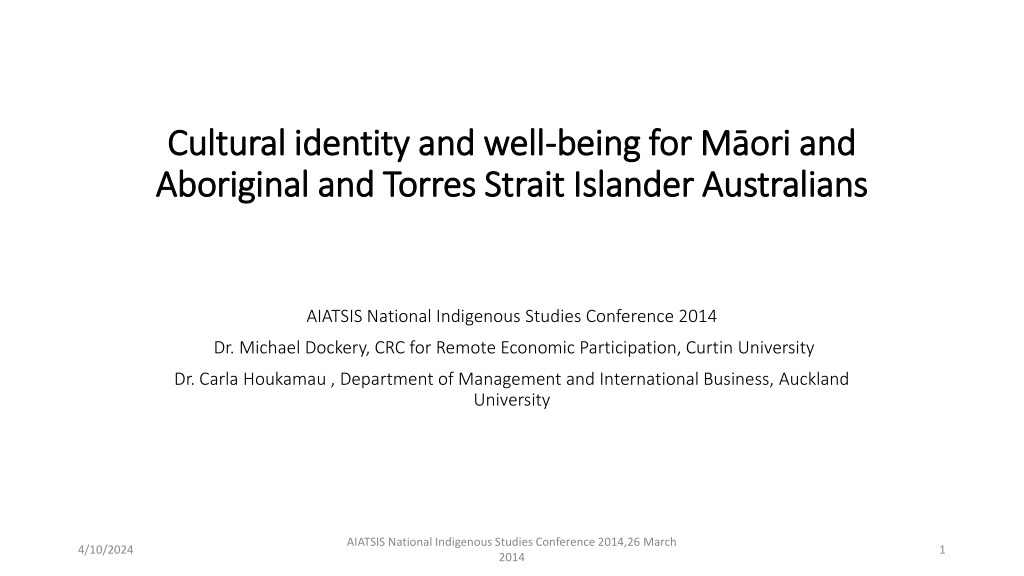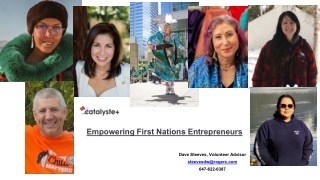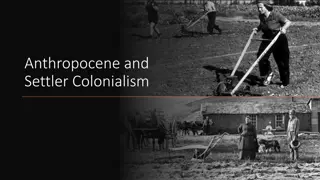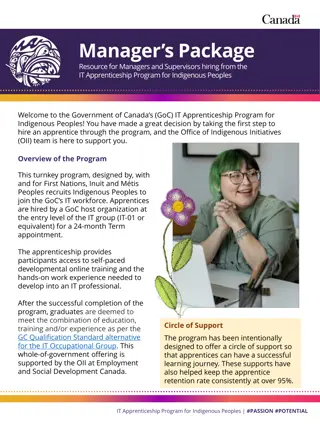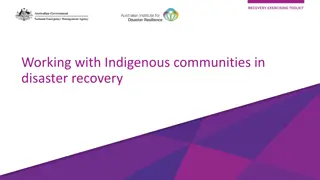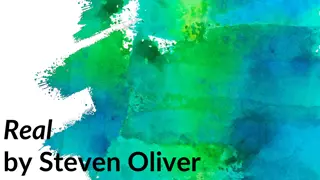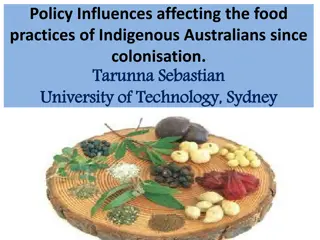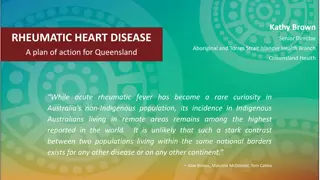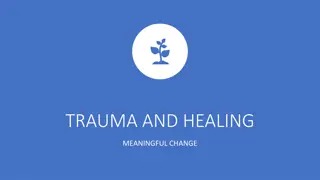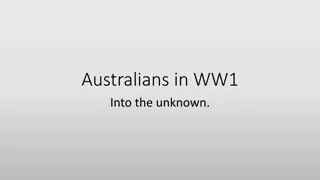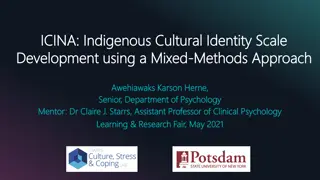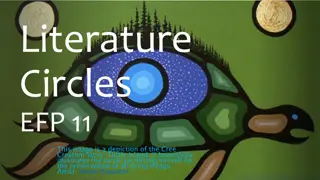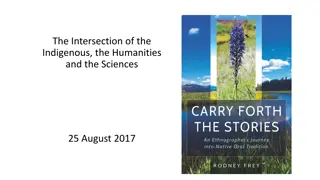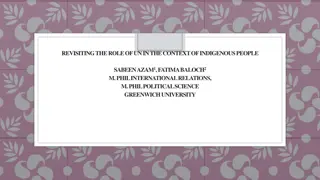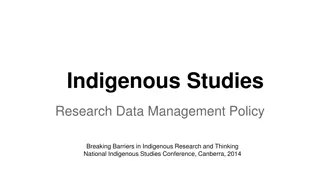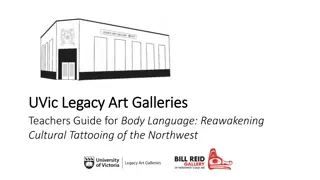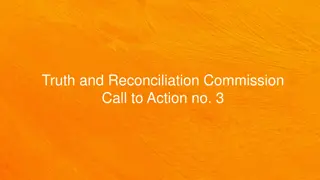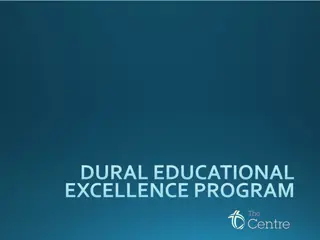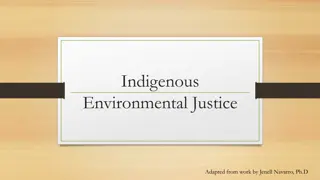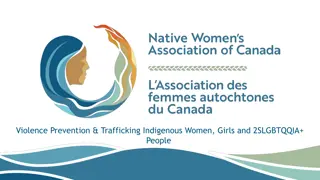Exploring Cultural Identity and Well-being Among Indigenous Australians
This study delves into the intricate relationship between cultural identity and well-being among Māori and Aboriginal/Torres Strait Islander Australians. It examines the impact of colonialism on identity, emphasizing the importance of connections to land, family, and kinship systems in shaping identity. Theoretical frameworks and indigenous perspectives shed light on the complexities of identity formation and its influence on overall well-being.
Download Presentation

Please find below an Image/Link to download the presentation.
The content on the website is provided AS IS for your information and personal use only. It may not be sold, licensed, or shared on other websites without obtaining consent from the author. Download presentation by click this link. If you encounter any issues during the download, it is possible that the publisher has removed the file from their server.
E N D
Presentation Transcript
Cultural identity and well Cultural identity and well- -being for M ori and Aboriginal and Torres Strait Islander Australians Aboriginal and Torres Strait Islander Australians being for M ori and AIATSIS National Indigenous Studies Conference 2014 Dr. Michael Dockery, CRC for Remote Economic Participation, Curtin University Dr. Carla Houkamau , Department of Management and International Business, Auckland University AIATSIS National Indigenous Studies Conference 2014,26 March 2014 4/10/2024 1
Overview Overview Collaboration/history. Aboriginal and Torres Strait Islander guidance/collaboration. Theoretical framework under development - exploring the relationships between cultural identity and wellbeing for M ori and Aboriginal and Torres Strait Islander Australians. AIATSIS National Indigenous Studies Conference 2014,26 March 2014 4/10/2024 2
Theoretical background Theoretical background Identity central to well-being. Ethnic identity problematic. Conventional (Western) - decontextualize individual experience. SDT - situates well being in the social/relational sphere. Ryan and Deci (2000). Three innate needs that, if satisfied, allow optimal function and growth: Competence, Relatedness, Autonomy. The central task of any culture/society is to provide its members with access to pro-social ways of meeting those needs. AIATSIS National Indigenous Studies Conference 2014,26 March 2014 4/10/2024 3
Mori/Aboriginal and Torres Strait Islander views on M ori/Aboriginal and Torres Strait Islander views on identity identity M ori Aboriginal and Torres Strait Islanders Connections to land/past in determining identity. Sources of identity in relation to land/family and extended kinship system. Interdependence. Narrative understandings. In a M ori ecology- identity is relational and contextual (attached to location). Whakapapa, iwi, hapu, wh nau. Sources of identity located in relational/physical/spiritual environment. AIATSIS National Indigenous Studies Conference 2014,26 March 2014 4/10/2024 4
Colonisation and Mori identity Colonisation and M ori identity Durie (1999): the alienation of M ori from their land and their culture subjects them to a fragmentation of identity associated with loss of self-esteem and spirit. Post colonial stress disorder (Turia, 2001) Psycho-cultural stress (Sachdev, 1990) Cultural depression (Keri Lawson Te Aho, 1998) AIATSIS National Indigenous Studies Conference 2014,26 March 2014 4/10/2024 5
Mori M ori culture, identity, sovereignty culture, identity, sovereignty Contemporary/dominant views of an ideal or healthy M ori identity cannot be separated from the movement towards M ori political/social and cultural self-determination. Culture as a cure. AIATSIS National Indigenous Studies Conference 2014,26 March 2014 4/10/2024 6
Mori M ori diversity diversity 2006 census* 643,977 (17.7%) M ori descent 556, 329 (14.6 %) - identify as M ori 52.8% = M ori only 42.2 % = Mixed M ori and other ethnic groups 7.0 % Pacific 1.5 % Asian ethnic groups 2.3 % 'New Zealander' Youthful population (median age 22) *Statistics New Zealand, 2007 7
Mori diversity M ori diversity Williams (2000) - M ori sub-groups. 1. Traditional core enculturated/rural. 2. Primarily urban urban dwelling/bi-cultural. 3. Unconnected biologically M ori 4. Kiwi or New Zealander - indistinguishable from P keh . 8
The Multi The Multi- -Dimensional Model of M ori Identity and Dimensional Model of M ori Identity and Cultural Engagement: MMM Cultural Engagement: MMM- -ICE ICE * M ori identification 1.Group Membership Evaluation and centrality of M ori identity 2.Authenticity Beliefs 3.Socio-Political Consciousness 4.Cultural Efficacy and Active Identity Engagement 5.Spirituality 6.Interdependent Self-Concept Visible cultural markers (extent to which individual looks physically M ori. AIATSIS National Indigenous Studies Conference 2014,26 March 2014 4/10/2024 9
The The relationship relationship between well well- -being being for for M ori between culture M ori culture and and 2009 initial sample n=270/2012 - n = 500 (verified validity of the scale) 2012/2103 - Website (www.M ori-identity.ac.nz) 1500 completed surveys associations between socio-political consciousness/cultural efficacy and improved psychological and well- being outcomes 10
The relationship between culture and well The relationship between culture and well- -being being Aboriginal and Torres Strait Islander Absence of a Treaty and culture as cure model . Promotion of assimilation/practical reconciliation. On going debate re constitutional recognition. Wh nau identity/competency via self-sufficiency. Self determination theory supports view can be seen as a resource in promoting well-being. Wh nau identity/competency via self-sufficiency. Although culture can be seen as a resource AIATSIS National Indigenous Studies Conference 2014,26 March 2014 11 4/10/2024
Conclusion/next steps Conclusion/next steps Culture can be seen as a tool towards promoting well-being. ARC Empirical testing of the theory using survey instruments to capture the dimensions of identity and cultural engagement for M ori and Aboriginal and Torres Strait Islander Australians. AIATSIS National Indigenous Studies Conference 2014,26 March 2014 4/10/2024 12
References References Christie, M.J. (1985), Aboriginal Perspectives on experience and learning: The role of language in Aboriginal education, Deakin University Press, Melbourne. Durie, M. (1999). Mental health and M ori development. Australian and New Zealand Journal of Psychiatry. 33 (1), 5-12. Greer, S. & Patel,C. (2000) The issues of Australian Indigenous World-views and accounting , Accounting, Auditing and Accountability Journal, vol.13, no. 3,pp.307-29. Houkamau, C. A., & Sibley, C. G. (2010). The Multi-Dimensional Model of M ori Identity and Cultural Engagement. New Zealand Journal of Psychology, 39, 8-28. Lawson-Te Aho, K. (1998). A Review of Evidence: A Background Document to Support Kia Piki te Ora o te Taitamariki: Strengthening Youth Wellbeing: New Zealand Youth Suicide Prevention Strategy. Wellington: Ministry of M ori Development. Ryan, R. M., & Deci, E. L. (2000). Self-determination theory and the facilitation of intrinsic motivation, social development, and well- being. American Psychologist, 55, 68 78. Sachdev, P. S. (1989). Psychiatric illness in the New Zealand M ori. Australian and New Zealand Journal of Psychiatry, 23 (4), 529-541. Thompson,S.J., Gifford, S.M.& Thorpe, L. (2000). The Social and cultural context of risk prevention: Food and Physical activity in urban Aborignal Community , Health Education and Behaviour,vol. 27, n.6, pp. 725-43. Turia, T. (2000) Speech to NZ Psychological Society Conference 2000, Waikato University, Hamilton. Retrieved 20 July 2005 from: http://www.beehive.govt.nz/ViewDocument.aspx?DocumentID=8466 Williams, J. (2000). The Nature of the M ori Community. Paper Presented to PSSM Conference, New Zealand Stage Services Commission. October, Wellington. Retrieved 9 July 2006 from: http://pssm.ssc.govt.nz/2000/papers/jwilliam.asp AIATSIS National Indigenous Studies Conference 2014,26 March 2014 4/10/2024 13
